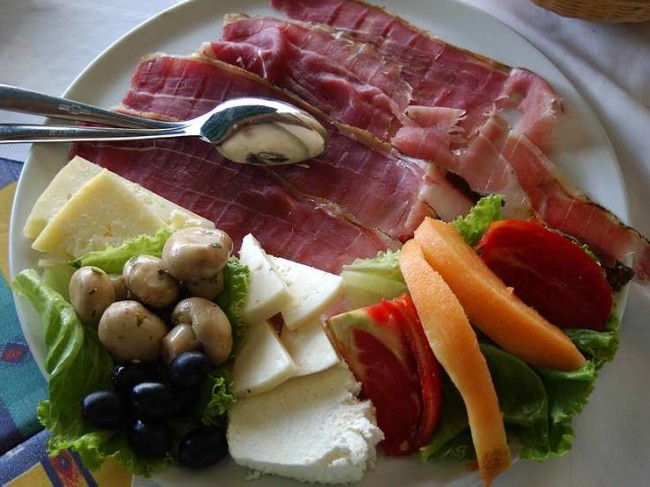


Oh, prosciutto! The king of dry-cured meat! Just a slice of it puts everything else on the plate to shame. Its healthy red color, its spicy taste, the sensation it creates in one’s mouth. Prsut itself is a culinary attraction.
Did you know that coastal Croatia has a long tradition of preparing this luxurious delicacy? It is a quite common grocery for people of the region. Italy (where prosciutto originated) is just across the Adriatic Sea, so it should make sense. Of course, Croats have made a few tweaks of their own to prsut, as they call it. So if you try it, be prepared for something new and unique. But let’s start from the beginning.
What is prosciutto, or prsut?
Basically, it is a pig’s hind leg or thigh dried, salted and pressed until all the juices are extracted (the name prsut comes from the Latin pro exsutus – to extract). This might sound simple, but the whole process can actually take up to two years, depending on the size of the leg. At some point, the ham is hung upside down outside so that the fresh air can do its part in the drying process. As a result, the location and climate can greatly influence the taste of the meat.
What kinds of prsut can you find in Croatia?
Two regions along the Croatian coast are known for their prsut: Istria and Dalmatia. They are also known for a distinctive Croatian cure-all, but that’s another story. As we have already stated, the climate of the area is very important for prsut preparation, so these regions hold special geographic licenses for prsut production. In other words, only the meat produced in Dalmatia or Istria will have the authentic prsut taste.
The major difference between the Istrian and the Italian way of preparing the meat is that Istrians remove the skin and the fat underneath it. Then they cover it with sea salt, pepper, laurel, rosemary and even garlic. Next, the meat is dried in the winter-season wind, called bura, until spring, when the ham is transferred to cold basements in order to secure the ideal temperature and moisture level. The whole process takes about eighteen months from start to finish.
Dalmatians, on the other hand, expose the meat to cold and smoke, intensifying the aroma ham already has. Another wind, called jugo, accompanies bura in the drying process. This is important because bura blows from the mountain Velebit, carrying with it the scent and aroma of herbs blooming there, while jugo blows from the sea, infusing the ham with the fresh saltiness of the Adriatic. It takes a little more than a year before the prsut is ready to be enjoyed.
Where can we eat prsut?
Most Croatian restaurants offer prsut as an appetizer (especially if it comes with sheep or goat cheese), but it can be also found as a main ingredient in pasta dishes. Prepackaged prsut is available in most major stores, although it is not as good as it is when freshly cut.
But if you fancy the real thing, visit a professional prsutana, or prsut store. If you’re in Istria, we suggest that you visit the small village of Tinjan, where the Milohanic family runs a generations-old business preparing prsut. The settlement of Sveti Petar u Sumi (literal meaning- St. Peter in Woods) is the home of the Jelenic prsut industry, but you can also buy their products in romantic Rovinj, cultural Pula or charming Labin. Milan’s butchery in Vodnjan also features a restaurant where you are always welcome to enjoy Istrian cuisine, while quality products by Pazin’s Pisinium are also a known to the market.
If you are in Dalmatia, several prsut places should be highlited on your map. The people of Drnis are considered masters in the art of prsut and have been serving their meat to royal courts since ancient times. The village Posedarje won several awards for its traditionally prepared prsut. Another place to check is Puntica beneath Velebit Mountain. The Matas company is a recipient of a Croatian Superbrand seal, and you can try their offerings in the headquartering village of Jasenice and in the geek-friendly capital of Zagreb. Vostane is another popular brand, known for its prepackaged but tasty “Dalmatiko” prsut.
As you can see, Croats take prsut very seriously. It is not just food, but a passion served on a plate, waiting to be discovered and consumed. If you happen to visit Istria or Dalmatia, be sure to try it at least once. You won’t be disappointed.
